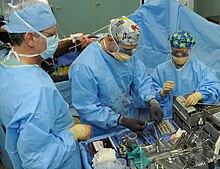Internal fixation
This article needs attention from an expert in Medicine. Please add a reason or a talk parameter to this template to explain the issue with the article. (February 2010) |
An internal fixator refers to the implant (medicine) used in internal fixation of bones during orthopedic surgery. The concept of internal fixation dates to the mid 1800's.[1]
An internal fixator may be made of stainless steel or titanium.
Types of internal fixators include bone screws and metal plates, pins, rods,[2] Kirschner wires and intramedullary devices such as the Kuntscher nail and interlocking nail.

Open Reduction Internal Fixation (ORIF) is a medical procedure. Open reduction refers to open surgery to set bones, as is necessary for some fractures. Internal fixation refers to fixation of screws and/or plates to enable or facilitate healing.
Rigid fixation prevents micromotion across lines of fracture to enable healing and prevent infection, which happens when implants such as plates (e.g. Dynamic Compression Plate) are used.
Open Reduction Internal Fixation techniques are often used in cases involving serious fractures such as comminuted or displaced fractures.
Risks include bacterial colonization of the bone, infection, stiffness, loss of range of motion, non-union, malunion, damage to the muscles, nerve damage and palsy, arthritis, tendonitis, pain associated from metal plates, screws, and pins.
See also
References
- ^ General Principles of Internal Fixation. URL: http://emedicine.medscape.com/article/1269987-overview Accessed 9 January 2010
- ^ MedicineNet.com URL: http://www.medterms.com/script/main/art.asp?articlekey=13714 Accessed 9 January 2010
